NCERT Solutions for Class 8 Science Chapter 8 Cell: Structure and Functions
NCERT Solutions for Class 8 Science Chapter 8 Cell: Structure and Functions are given below. Here we have provided the best and error-free answers to all the exercise questions that will strengthen your foundation in science. Solving NCERT questions will assist you in grasping the content in the Crop Production and Management chapter in a better way.
In these solutions, we have answered all the intext and exercise questions provided in NCERT class 8 science textbook. NCERT Solutions for Class 8 Science Chapter 8 Cell: Structure and Functions provided in this article are strictly based on the CBSE syllabus and curriculum. Students can easily download these solutions in PDF format for free or can read them online.
Cell: Structure and Functions Class 8 Science NCERT Solutions
Exercise Questions
Question 1. Indicate whether the following statements are True (T) or False (F).
(a) Unicellular organisms have a one-celled body.
(b) Muscle cells are branched.
(c) The basic living unit of an organism is an organ.
(d) Amoeba has an irregular shape.
Answer:
(a) True
(b) True
(c) False
(d) True
Question 2: Make a sketch of the human nerve cell. What function do nerve cells perform?
Answer:
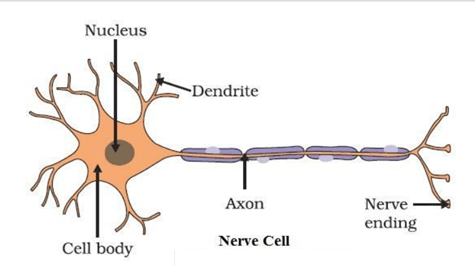
The function of a nerve cell is to transmit messages to the brain and also to take away messages from the brain to the receptor organs. Thus, it controls the working of different parts of the body
Question 3: Write short notes on the following:
(a) Cytoplasm
(b) Nucleus of a cell
Answer:
(a) Cytoplasm: It is a fluid that fills the cell and occurs between the plasma membrane and the nucleus. Cell organelles such as mitochondria, ribosomes, Golgi bodies, etc. are suspended in the cytoplasm. The cytoplasm helps in the exchange of materials between cell organelles
(b) The nucleus of a cell: The nucleus is a spherical structure generally present at the centre of a cell. The nucleus is composed of the following components:
(i) Nuclear membrane: It is a double-layered membrane which separates the contents of the nucleus from the cytoplasm. The nuclear membrane has nuclear pores that allow the transfer of specific substances in and out of the nucleus.
(ii) Nucleolus: It is a small spherical body that is not bound by any membrane.
(iii) Chromosomes: These are thread-like structures that carry genes. Genes contain information necessary for the transfer of characteristics from the parents to the offspring. Thus, chromosomes play an important role in the inheritance of characteristics.
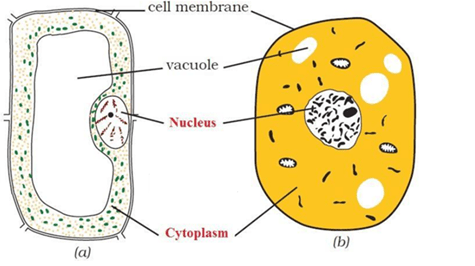
Question 4: Which part of the cell contains organelles?
Answer: Cytoplasm, gelatinous fluid inside a cell contains various organelles like mitochondria, Golgi bodies, ribosomes etc.
Question 5: Make sketches of animal and plant cells. State three differences between them.
Answer:
| Plant cell | Animal cell |
| They are large in size | They are smaller than plant cells |
| The cell wall is present | The cell wall is absent |
| Vacuoles are large | Vacuoles are small |
| Plastids could be seen | Except for Euglena, Plastids could not be seen in animal cells. |
Question 6: State the difference between eukaryotes and prokaryotes.
Answer:
| Prokaryotes | Eukaryotes |
| Most prokaryotes are unicellular. | Most eukaryotes are multicellular. |
| The nucleus is poorly defined due to the absence of a nuclear membrane. | The nucleus is well defined and is surrounded by a nuclear membrane. |
| Nucleolus is absent | Nucleolus is present. |
| Cell organelles such as plastids, mitochondria, golgi bodies, etc. are absent. | Cell organelles such as plastids, mitochondria, golgi bodies, etc. are present. |
| Bacteria and blue-green algae are prokaryotic cells. | Fungi, plant, and animal cells are eukaryotic cells. |
Question 7: Where are chromosomes found in a cell? State their function.
Answer 7: Chromosomes are found in the nucleus of the cell. These carry genes and help in inheritance or transfer of characters from the parents to the offspring.
Question 8: ‘Cells are the basic structural units of living organisms’. Explain.
Answer: Cells constitute various components of plants and animals. A cell is the smallest unit of life and is capable of all living functions. Cells are the building blocks of life. This is the reason why cells are referred to as ‘the basic structural and functional units of life’. All cells vary in their shapes, sizes, and activities they perform. In fact, the shape and size of the cell is related to the specific function it performs.
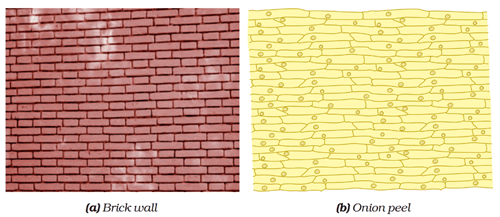
Question 9: Explain why chloroplasts are found only in plant cells?
Answer 9: Chloroplasts are found in plant cells only because chloroplasts contain chlorophyll which is essential for photosynthesis. Chlorophyll traps cell energy and use it to prepare food for plants.
Question 10: Complete the crossword with the help of clues given below:
Across
1. This is necessary for photosynthesis.
3. Term for component present in the cytoplasm.
6. The living substance in the cell.
8. Units of inheritance present on the chromosomes.
Down
1. Green plastids.
2. Formed by collection of tissues.
4. It separates the contents of the cell from the surrounding medium.
5. Empty structure in the cytoplasm.
7. A group of cells.
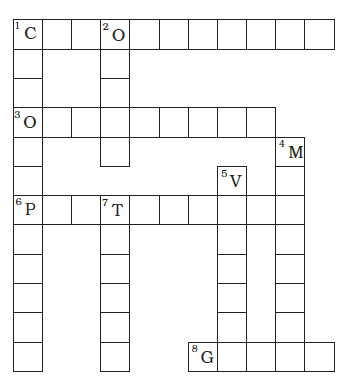
Answer:
Across
1. Chlorophyll
3. Organelle
6. Protoplasm
8. Genes
Down
1. Chloroplasts
2. Organ
4. Membrane
5. Vacuole
7. Tissue
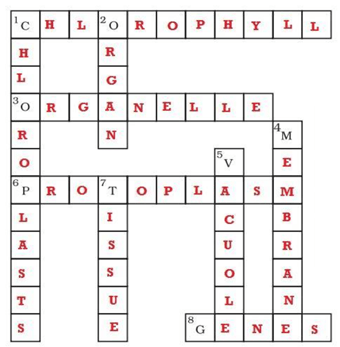
NCERT Solutions for Class 8 Science Chapter 8 – A Brief Discussion
CBSE Class 8 Science NCERT Solutions Chapter 3 helps students to clear their doubts and to score good marks in the board exam. All the questions are solved by experts with a detailed explanation that will help students complete their assignments & homework. Having a good grasp over CBSE NCERT Solutions for Class 8 Science will further help the students in their preparation for board exams and other competitive exams such as NTSE, Olympiad, etc.